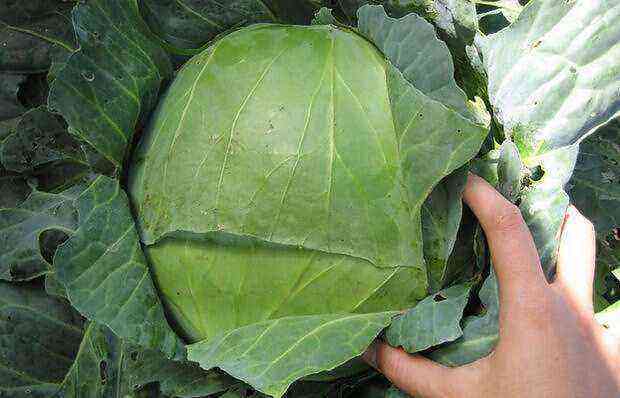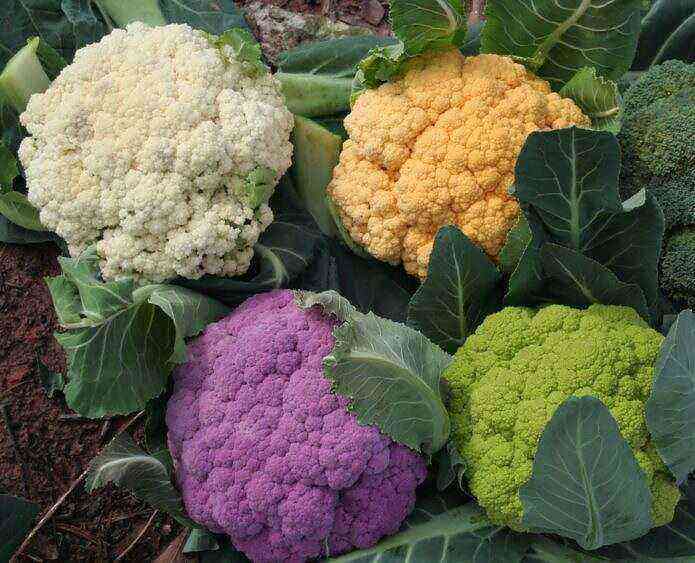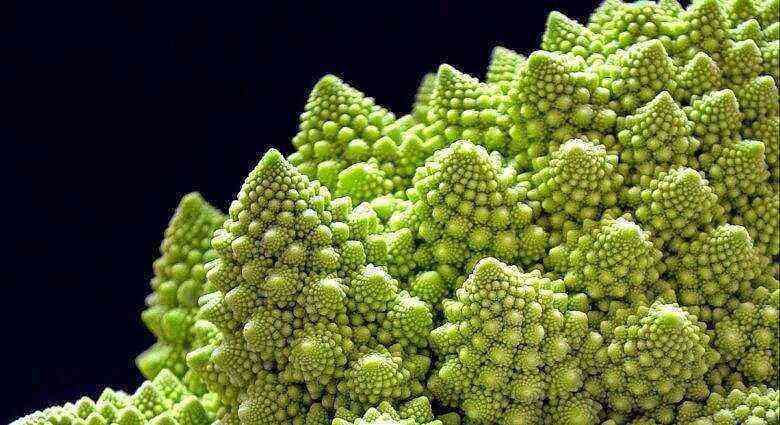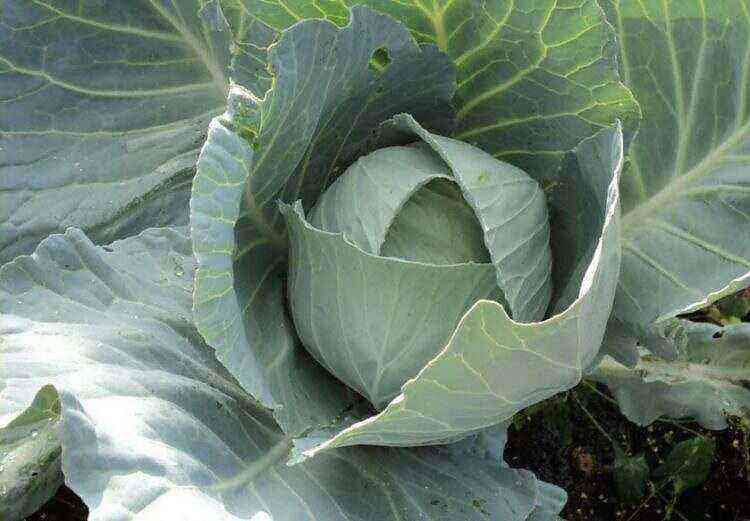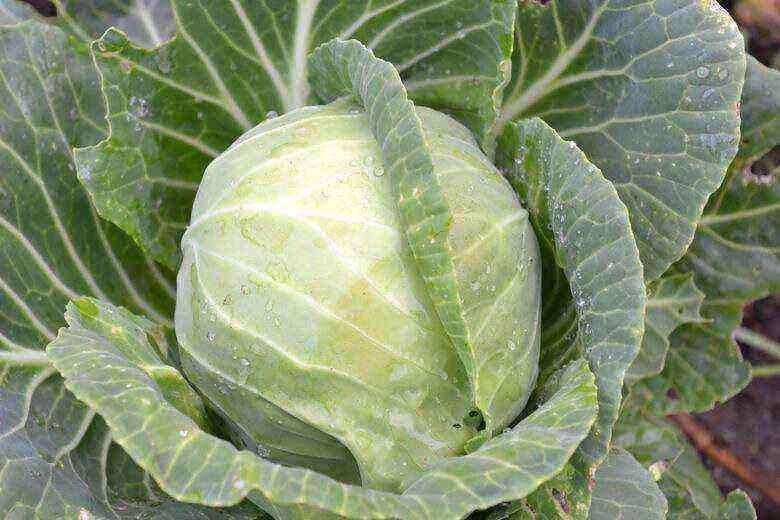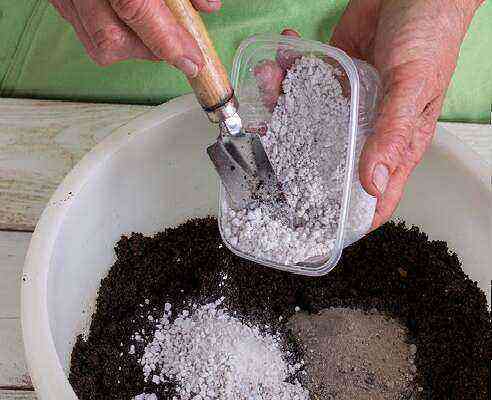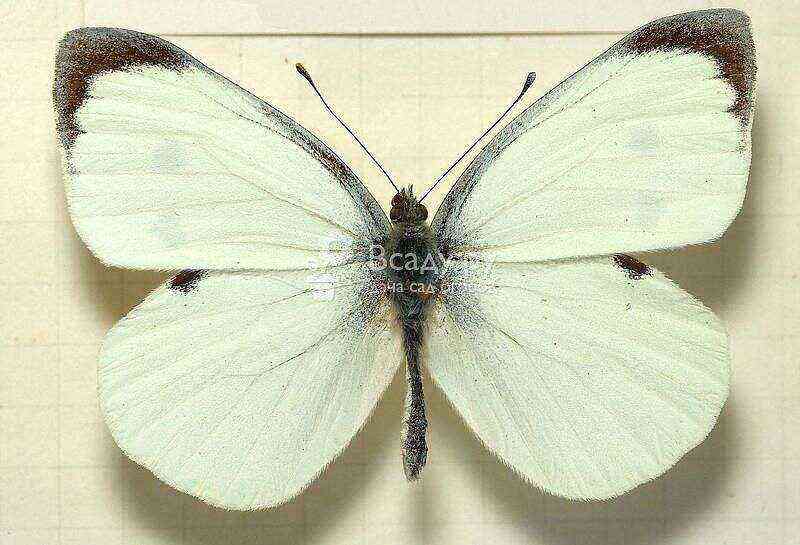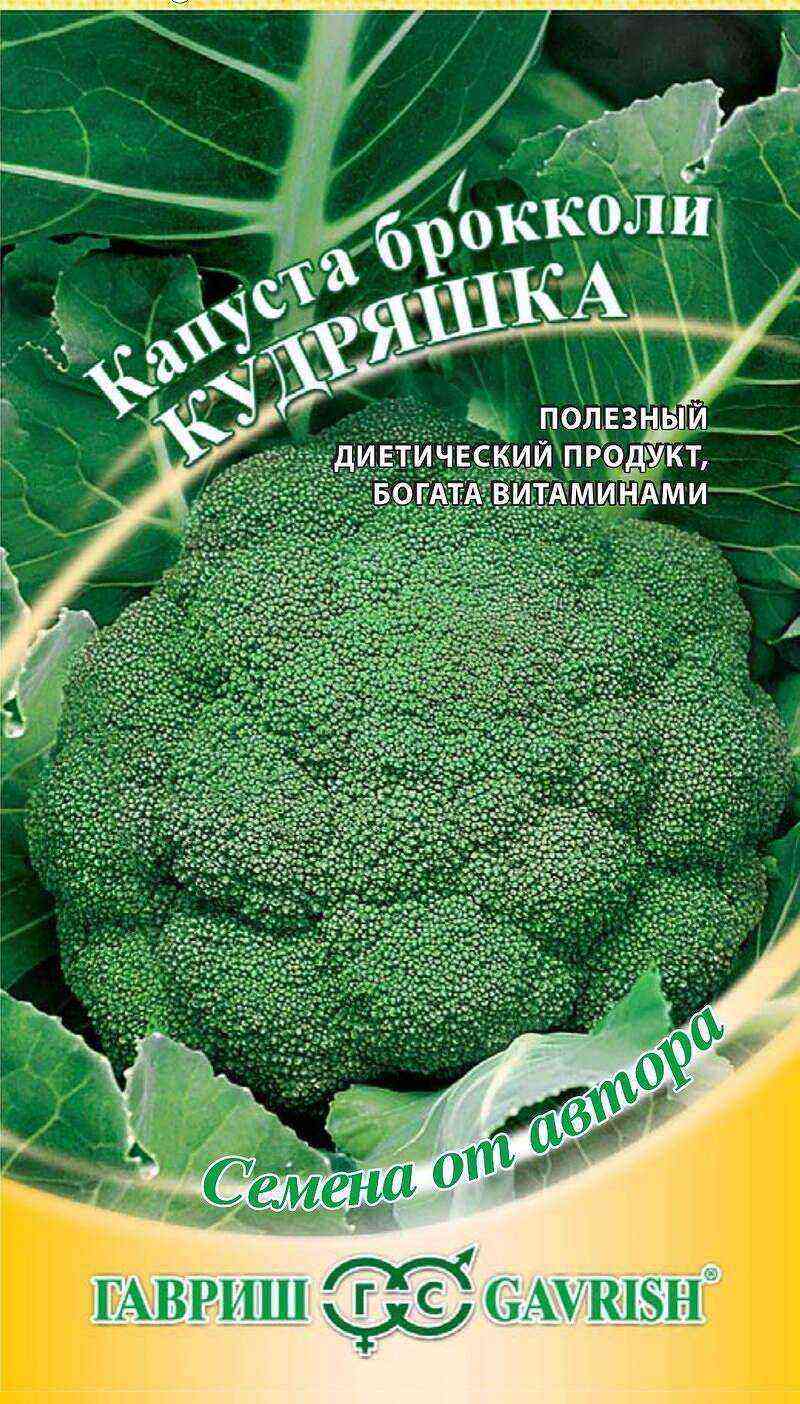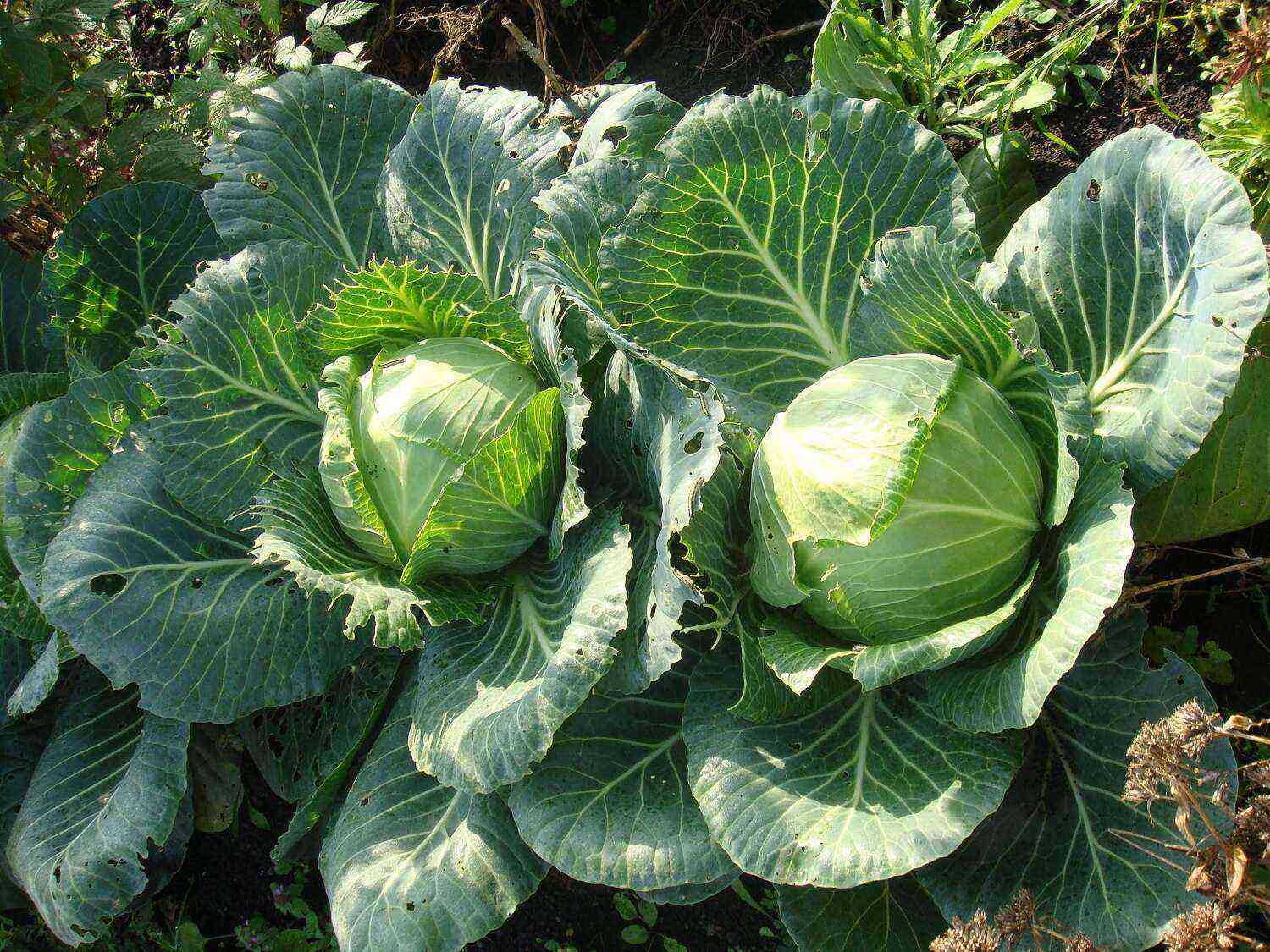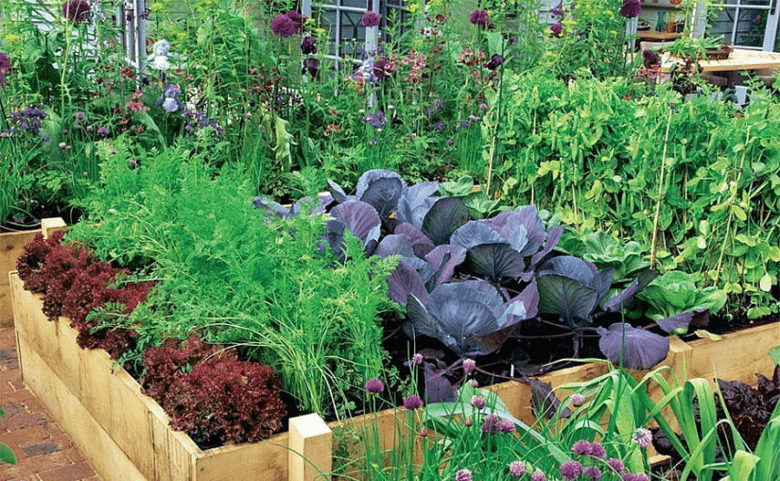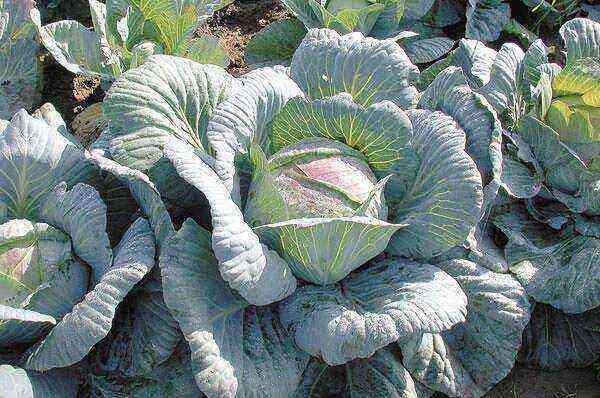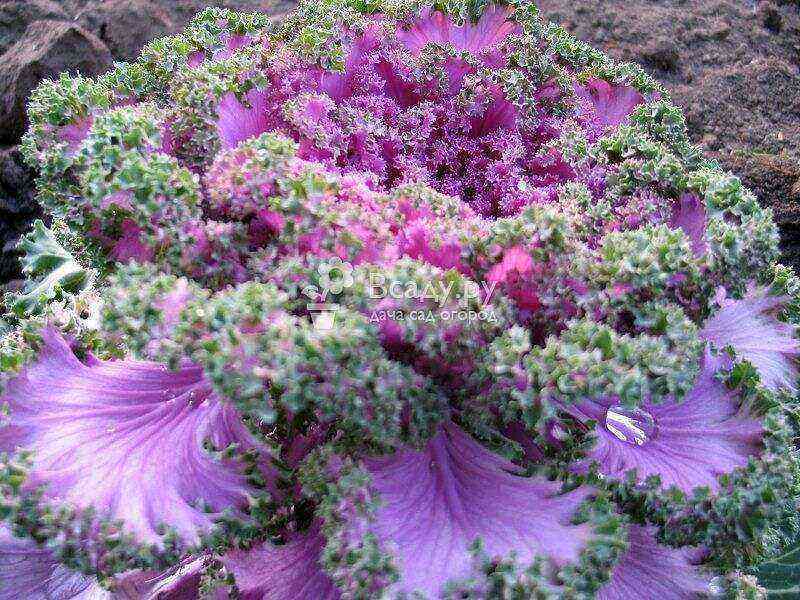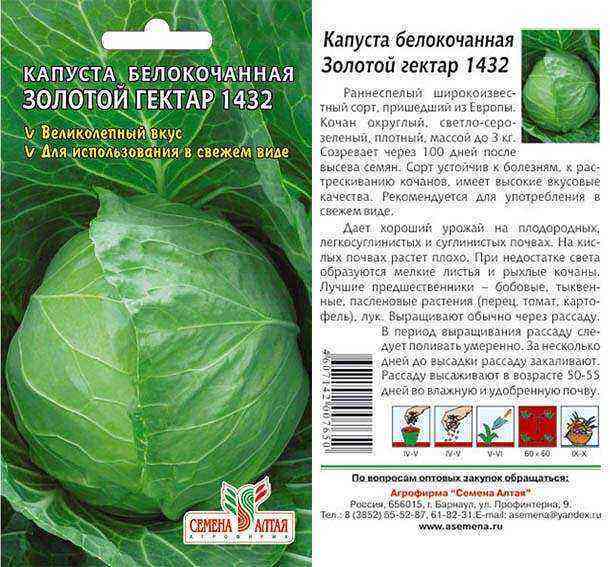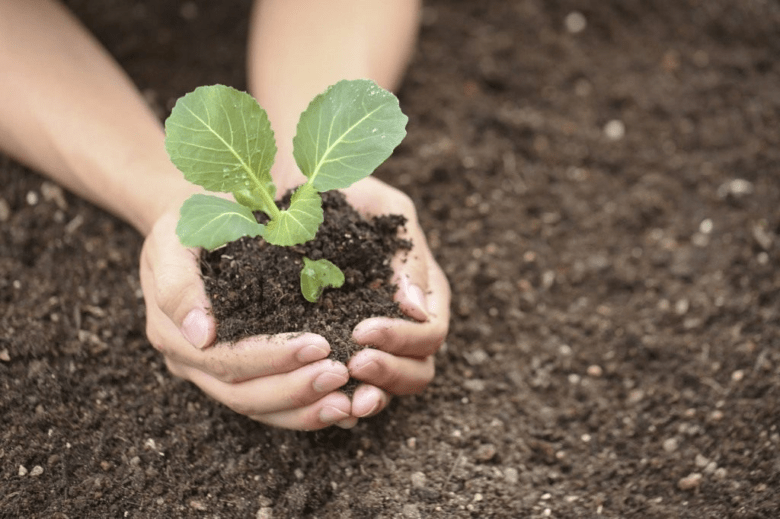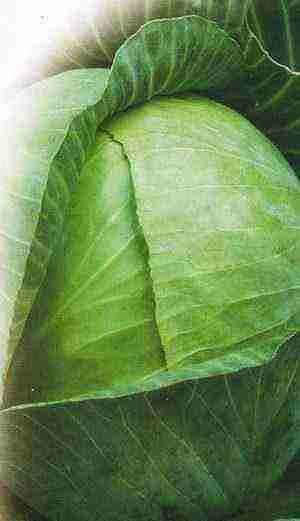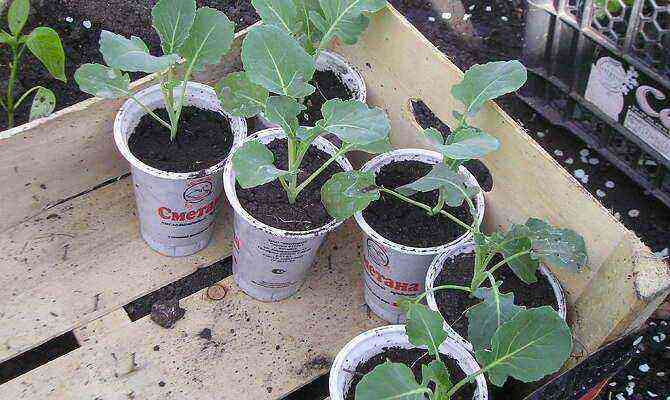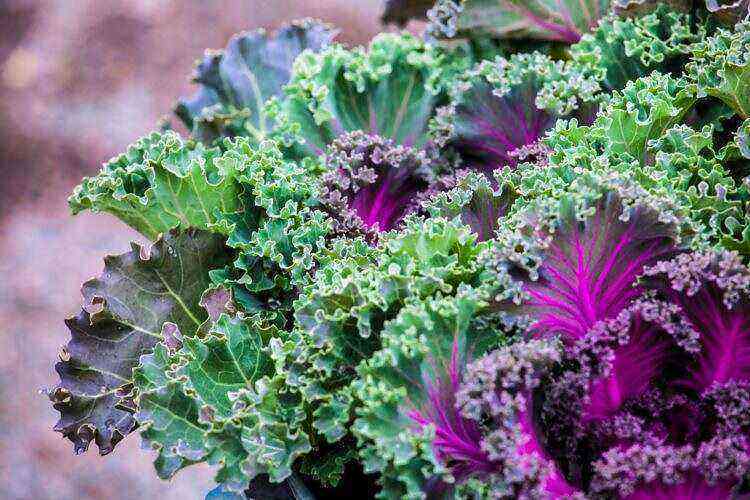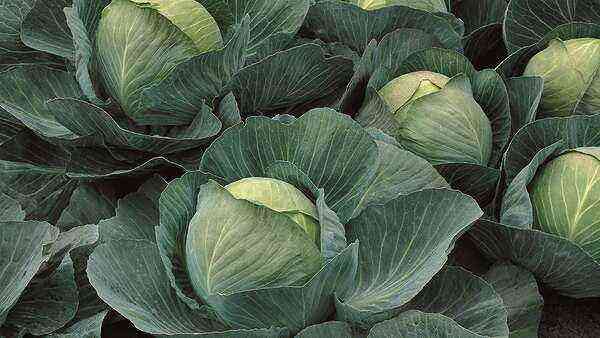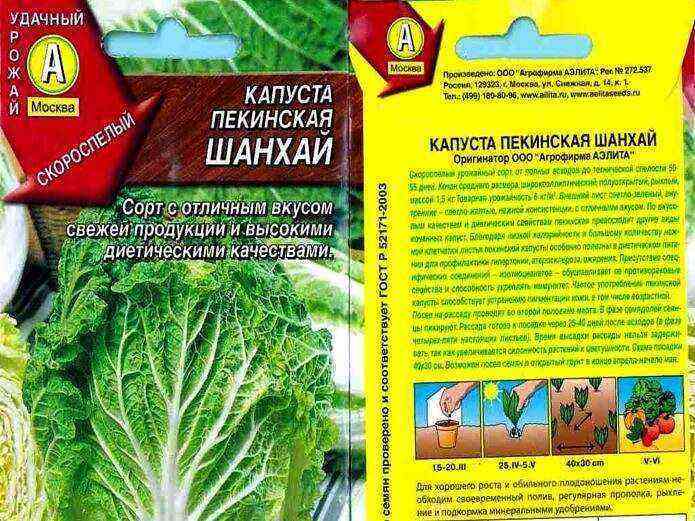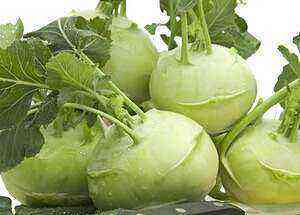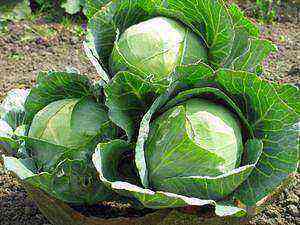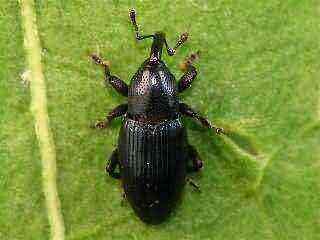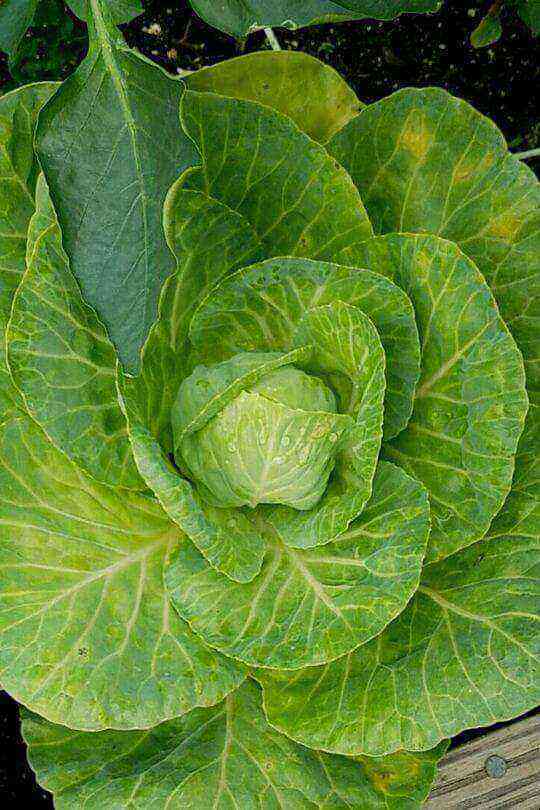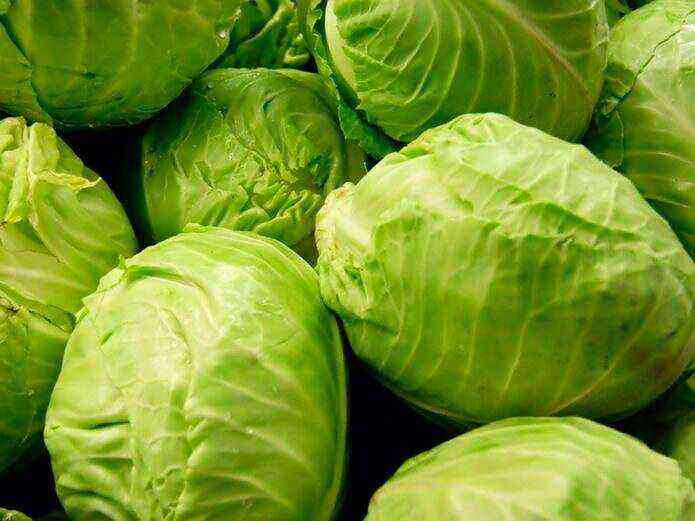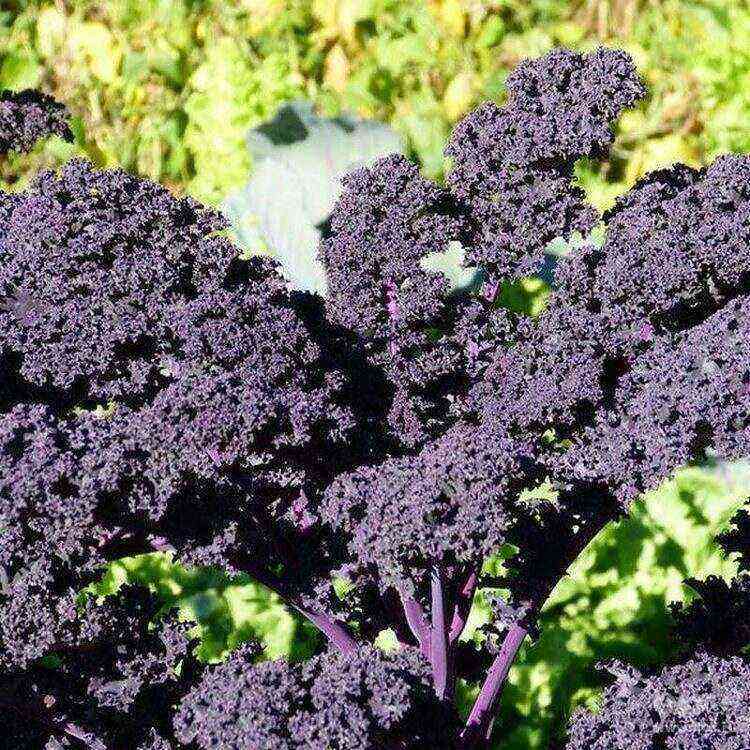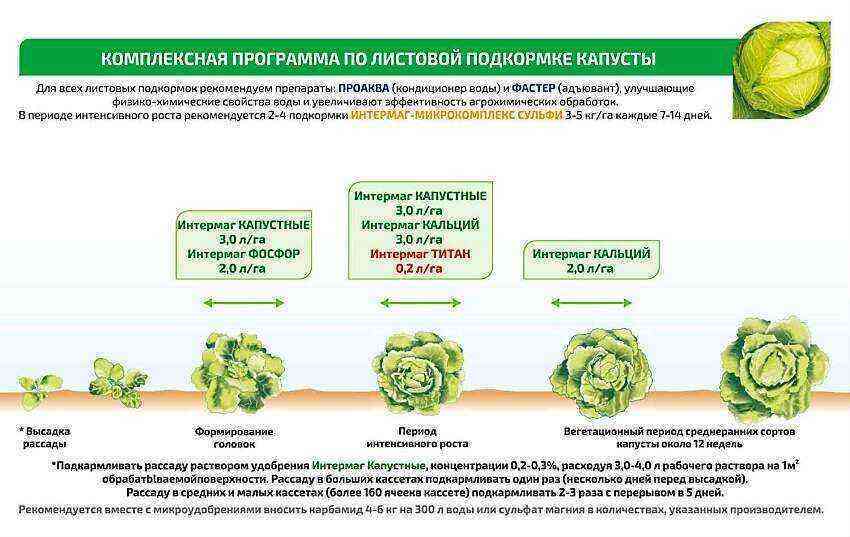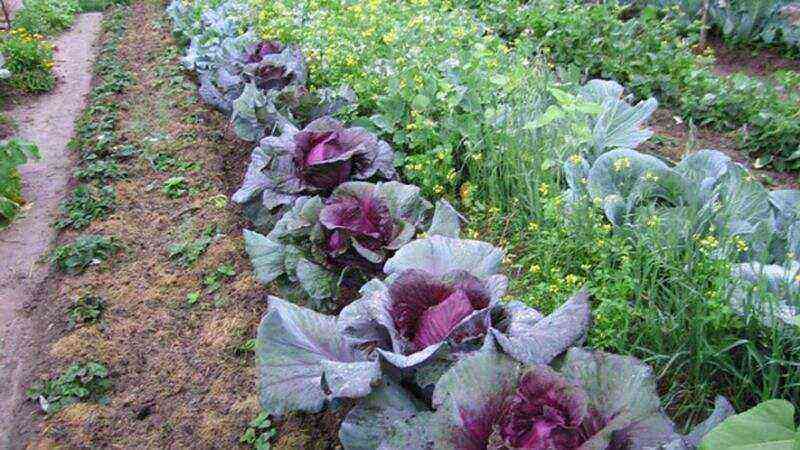Cabbage is a good appetizer, and the table is not empty and it is not a pity to eat … A strategically important product, it is on a par with wheat, potatoes, beets. What family in Russia does not ferment cabbage in November? Therefore, it is so important to save the harvest from the encroachments of various “raiders”.
Fungal diseases
Delicious, healthy, beloved
The enemy, i.e. diseases of cabbage, you need to know by sight …
pounds
pounds – a severe fungal disease, nests only on the cruciferous family. The causative agent of cabbage disease is fungus (лат. Plasmodiophora brassicae Wor.). The roots of cabbage are overgrown with ugly buds of different sizes. The cabbage bush gradually withers, the leaves turn yellow, if the plant is young, the head of cabbage may not start. Infection occurs quickly on the garden bed, and up to 60% of the crop dies.
The fungus lives in the ground, is introduced with seedlings, wind, harmful insects. You can bring a lump of dirt on your shoes from a nearby area affected by this fungal disease. The disease-causing keel fungus lives in the soil for 5-7 years.
How to fight? Immediately, without hesitation, pull out diseased plants and destroy the rhizome, burn outside the garden plots. In no case should diseased stumps be put into the compost pit. But the heads of cabbage, if any, are quite edible. Now we need to take care of the contaminated soil (7 years old! Remember?). The most environmentally friendly, efficient and simple way is to maintain a crop rotation.
The fungus does not like plants of the nightshade family: potatoes, eggplants, tomatoes will destroy the keel in 3 years. The onion family will cope in 2-3 years. Beetroot will cope with the infection in 2 years.
Breeders brought grade cabbage keel resistant.
White-washed:
- Tequila F1,
- Hope,
- Kilaton F1 (Syngenta),
- Winter mushroom 11.
color:
Beijing:
It will not hurt to carry out protective and preventive measures, the fungus loves acidic soil: pour quicklime on open beds, spending at least 0,5 kg of substance per 1 sq. M. In greenhouses, additionally treat the soil with boiling water and steam.

White rust
Carefully examining the bush, you can find white convex spots on the cabbage leaves. These are manifestations of a fungal disease white rust. Neoplasms – pustules, these are a kind of myceliums. Are the foci of infection. The parts of the plant affected by the disease are deformed, thickened, the leaves curl. The taste and useful properties of vegetables are decreasing exponentially.
The causative agent of the disease – гриб White Candida. Weeds of the cabbage family are a breeding ground for infection.: core, shepherd’s purse, grains.
Exacerbate and spread:
- frequent precipitation,
- bad weather,
- drops of moisture on the leaves of the plant.
Have you discovered a disease? Immediately sprinkle cabbage beds fungicide Ridomil Gold.
In winter, fungal spores feel great in plant heaps, so in the fall they do a general cleaning of the garden, disinfect the soil. All diseased plants are destroyed outside the plots, in no case are they left in compost pits.
This disease also causes great damage to other cabbage: radishes, turnips, horseradish.

Blackleg
Blackleg, “Loves” almost all vegetable plantings in the garden. Plants die mainly at the stage of growing seedlings. Cruciferous plants are affected at different stages of development.
Disease spores live in the ground, in favorable conditions actively reproduce:
- increased acidity of the soil (to combat, use quicklime, 0,5 kg per 1 square meter)
- stagnation of moisture in the soil (drainage bends in the beds)
- non-observance of crop rotation (the soil is depleted, diseases accumulate)
- the beds are too densely planted with seedlings
- lack of proper care, not loose soil.
The roots are the first to suffer. The root collar turns black and dries up. The bush dies immediately or lags behind in development, the sides of the head of cabbage and leaves begin to rot. Harvesting the end …
Protection and prevention black leg:
- the soil for seedlings must be poured with boiling water, wrapped in cellophane and left to cool, then ignited in the oven;
- to regulate acidity, add ash 100 g per 1 sq. m;
- soak the seeds in potassium permanganate for 1 hour;
- at the stage of growing seedlings, use chemical and biological agents: Fitosporin-M, Metaxil.
If the black leg nevertheless settled in the beds, it is urgent to take arrangements:
- remove and destroy the affected plants outside the garden;
- loosen the beds thoroughly, prevent moisture stagnation;
- spray cabbage bushes with biological preparations: Fitosporin, which is diluted with 5-6 grams per 10 liters of water;
- chemical preparations: Trichodermine, 100 ml per bucket of water.

Mučnistaâ rosa
Powdery mildew is a dangerous, ubiquitous disease. Vegetables, berries, flowers, fruit crops go to everyone … It spreads through plants very quickly,
- spores are carried by the wind through the air,
- stay on garden tools,
- on work gloves,
- carried by irrigation water.
Signs of illness on cabbage:
- yellowish spots on the outside of the leaf,
- grayish bloom on the back, it is easy to remove it by hand, but it appears again and again.
White bloom (a waste product of fungi) disrupts the processes of photosynthesis. The leaves of a diseased plant wither and fall off. The plant gradually dies.
Observing all the rules of agricultural technology you will save your garden from many problems, including powdery mildew on cabbage:
- Regular crop rotation,
- weeding,
- loosening,
- top dressing with potash and phosphorus fertilizers.
But this is only prevention.
At the first suspicion, the biological preparation Fitosporin-M can help. You can use it after about a quarter until you get rid of the infection.
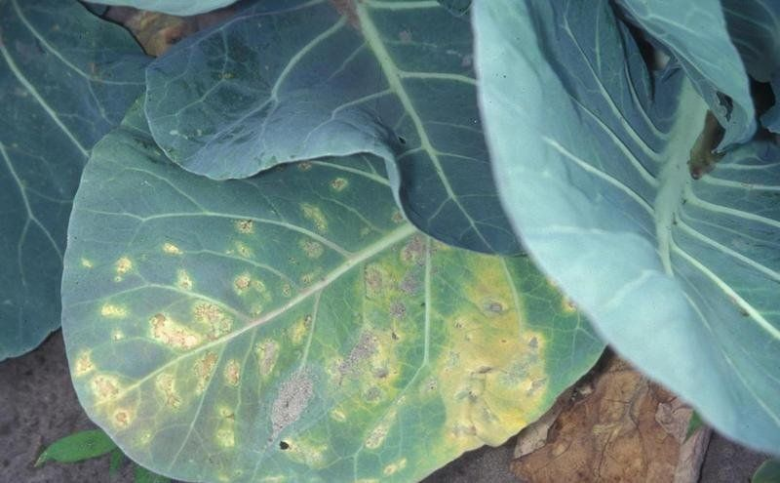
The use of fungicides will be effective:
- Fundazol,
- Rovral,
- Ditan M-45
- or time-tested copper sulfate.
Downy Mildew
Peronosporosis of cabbage, a type of powdery mildew. Parasitic fungi – oomycetes infect all types of garden plants. External signs and routes of infection are not much different. The spores of the fungus overwinter in uncleaned plant debris, in various secluded corners. With the onset of heat, the mushroom begins its subversive activity.
The fungus does not like dry, hot weather, but heat and dampness greatly reduce its incubation period. The defeat of a large area of plantings occurs in a maximum of a week. A significant role in the spread of fungal diseases is played by harmful insects: aphids, slugs, whiteflies.
A grayish fluff on the back of the leaf is the difference between downy mildew. The affected leaves quickly become covered with brown-brown spots, gradually dry out. This part of the diseased plant is also a carrier of the pathogen.
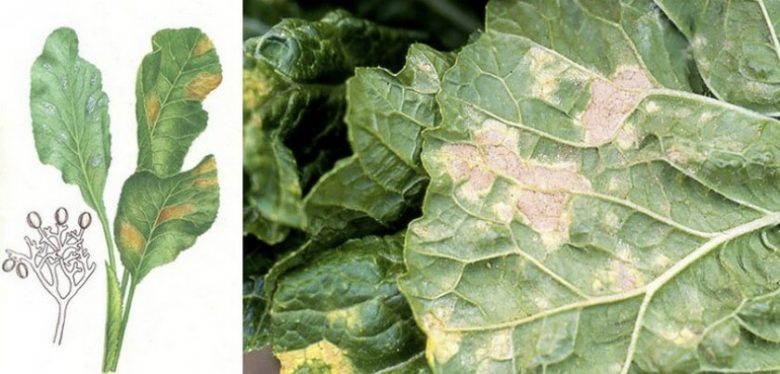
How to fight? Let’s start with prevention:
- Annual digging of the soil in late autumn will save the garden from many diseases and pests.
- Regular, conscientious gardening also yields results.
- Don’t forget about crop rotation. The best predecessors: nightshade, green manure.
This time, folk methods will help in treatment:
- 100 grams of ash is brewed with 3 liters of boiling water. Filter, dilute in 10 liters of water and process cabbage bushes.
- It is worth trying this recipe: dissolve 10 drops of iodine in 1 liter of milk and mix with 10 liters of water. The mixture is sprayed on the beds. Suitable for all horticultural crops.
The enemy in this case is very dangerous and most likely you cannot do without chemistry. Fungicides will help, as always, for example:
- “Ridomil Gold”,
- “Impact”,
- “Topaz”.

White rot
Causative agent white rot – mushroom Sclerotinia sclerotiorum. The disease usually affects crops at the end of the growing season, outdoors and during storage. High humidity, unstable weather contribute to the growth of pathogenesis (in contrast to cabbage phomosis). The fungus lives in the ground, in places where garden products are stored.
On the outside of cabbage heads, foci of mucus appear. A white, cotton-like, moist mycelium forms between the leaves.
Note! If rotten cabbage appears during storage, the rot quickly spreads, and neighboring heads of cabbage gradually become infected and deteriorate. Periodic inspection and grading will help preserve the crop.
Prevention and protection methods:
- Thorough cleaning and disinfection of storage areas for garden products.
- Storage temperature 0 + 1C.
- Heads of cabbage must be whole and not frozen.
- Leave 2-3 top leaves on the head.

Gray mold
Gray rot – botrytidiosis, affects cabbage during storage, like white rot of cabbage. Black specks or light gray fluffy mold appear on the surface of the head of cabbage. Fungal spores remain viable for several years in the storage areas of the cabbage crop. The situation is aggravated by high humidity. Disease prevention and crop protection methods are the same as in the case of white rot… A few more points can be added:
- Compliance with the rules of crop rotation (multi-field principles)
- Timely removal of mature heads of cabbage from the beds
- Cleaning beds from stumps, dead vegetation
- Disinfection of vegetable storages.
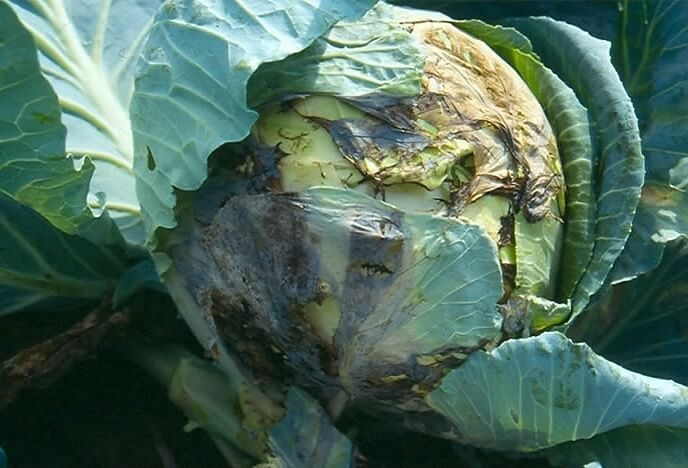
Alternaria
The causative agent is the fungus Alternaria brassicae. Cabbage Alternaria primarily affects the seeds and testes of cruciferous crops. This is the main reason for poor germination; infected seedlings often die.
Infected seedlings are covered with black dots and stripes, and quickly rot. Surviving plants will not give a rich, strong harvest. Small dark spots appear on the covering leaves, covered, as if with soot, these are fungal spores.
The stain decays, holes appear. The mold on cabbage feeds on sugar by pulling it out of the vegetable. The palatability deteriorates sharply. The cauliflower inflorescences become covered with brown rot, the disease does not penetrate deeply, but the appearance loses its attractiveness, and the fruits taste.
How to save the harvest? We start with correct agricultural technology:
- Meticulous cleaning old plants from the site.
- Crop rotation seeds. Experienced gardeners have a content plan for several years. Planting drawing, thoughtful sequence of vegetables, multi-field principles.
- Etching seeds, even purchased, in a solution of potassium permanganate. Or the use of TMTD – a seed disinfectant.
- Hydrothermal treatment seed material (a set of measures: bubbling, vernalization).
- Reasonable and thorough care behind the garden during the season.
- Application fungicides: The drug “Quadris” has proven itself well. Effective against 4 classes of mushrooms. Not dangerous for the environment, quickly decomposes.
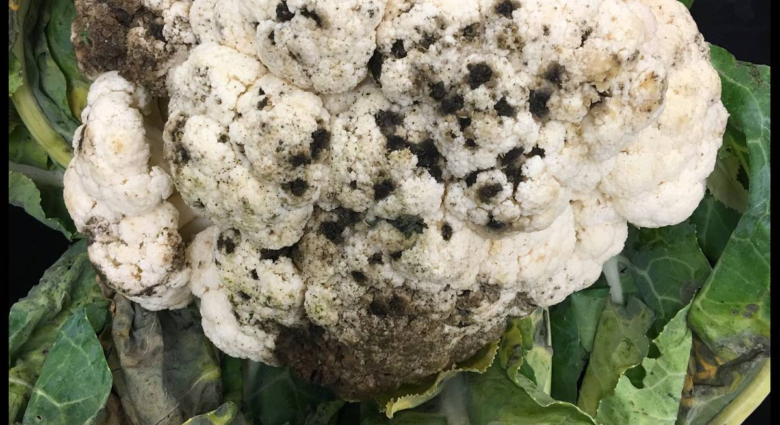
Risectoniasis
Brings the disease to the mushroom Rhizoctonia solani Kuhn. More than others “loves” late varieties of cabbage and garden roots, carrots, beets, potatoes ,. He does not disdain wheat and even hemp.
The main symptoms: rot spots on root crops, on outer leaves and stumps, scab on cabbage.
The affected tissue changes color to light brown, a white bloom appears – this is the mycelium of the fungus. The fungus gradually colonizes the entire plant, the leaves become watery, rot, some quickly age and wither. Total in 10 days the plant can die.
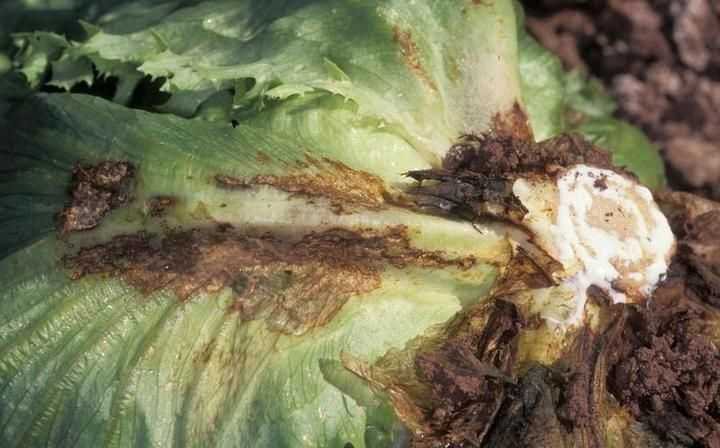
The fungus lives in the soil, its accomplices:
- humidity,
- consistently warm weather without temperature changes
- drops of moisture on the leaves.
The fight against rhizoctoniosis:
- Crop rotation, fertilizing with fertilizers, proper agricultural technology.
- It is useful to make high, raised beds for cabbage; this provides excellent drainage.
- To preserve the harvest, remove infected forks without regret.
- Harvest vegetables before frost. The temperature range for storing cabbage is from 0 to +5 degrees. Severe disinfection of vegetable storage.
- Treat the seeds before planting, and seedlings at the stage of 2-3 sheets with “Fitolavin 300 C”.
- Remove infected seedlings.
Fitoftoroz
Causative agent of the disease: mushroom Phytophthora porri Foister.
The pathogen settles in the stalk and begins the lesion from the depths of the stem, spreading along the head of cabbage. The head of cabbage rots from the inside. The mycelium of the fungus is white, clearly visible between the leaves. This feature distinguishes phytophthorafrom cabbage from mucous bacteriosis.
The fungus, like many representatives of this class, lives in the soil. High humidity and warm air +20 – 25 degrees, provoke the rapid development of the pathogen. Feels great at 0 degrees. That allows him to actively spoil the harvest in vegetable stores in any conditions.
On a note! The popular operation of removing rotten leaves during storage only exacerbates the situation. re-infection with late blight occurs.
Mushroom Phytophthora porri bulbous crops are also affected: lilies, onions, tulips. Therefore, a popular method of controlling the pathogen is crop rotation, which excludes the planting of bulbous crops.
The use of chemicals, especially folk methods, does not give a result, it is impossible to cure the plant.
Resistant to late blight varieties of cabbage do not yet exist.
Fusarium wilt
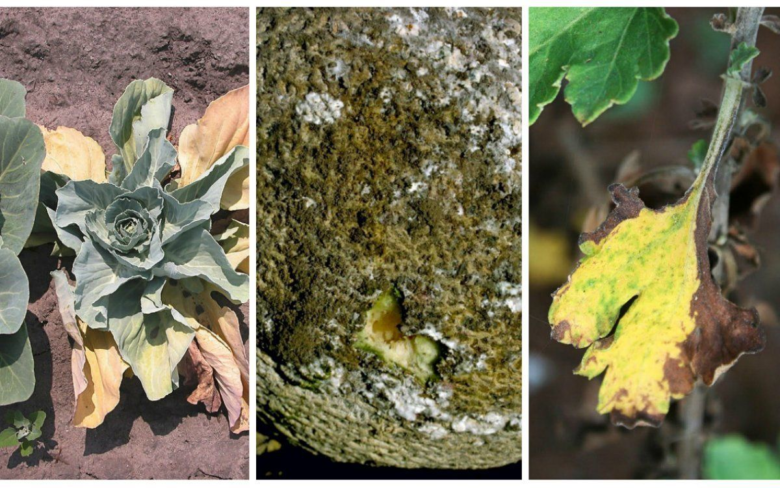
This disease is also called Yellowness or Jaundice of cabbage… All cruciferous garden crops are susceptible to infection. The disease nests mainly on cabbage, other types are less likely to suffer: cauliflower, broccoli, collard.
Infected seedlings die by 90%, the leaves turn yellow and die off.
In adult plants, the same signs, yellow spots on cabbage. Small, underdeveloped heads of cabbage are formed. If you cut off the stem, then the dark ring of blood vessels is clearly visible.
The source of the infection lives in the soil. Distribution is ubiquitous, but prefers southern regions. Air humidity does not matter, but hot weather stimulates the growth of the pathogen. The lack of potassium in the soil also has a beneficial effect on the development of the fungus.
We start the fight, as always, with agricultural technology:
- Burn diseased plants.
- Disinfect soil, incl. in greenhouses and hotbeds.
- Presowing seed treatment.
Fusarium is not a rare and serious disease; chemical preparations do not always cope with it. Crop rotation is also not a panacea, because Cruciferous weeds help spread the infection.
Cultivation of disease resistant F-1 hybrids is a priority. There are already a lot of such types of cabbage:
- SB-3,
- Kolobok,
- Valentine,
- Orbit,
- Favorite,
- Dominant.
Diseases of a viral and bacterial nature
In addition to fungal diseases, cabbage can be affected by diseases of a different nature: viral or bacterial
Vascular bacteriosis
Causative agent: the bacterium Xanthomonas campestris. The bacterium can infect plantings at any stage of development. From seedlings to storage in the cellar. During this period, a friend and relative of Xanthomonas, a mucous bacteriosis, often appears. It threatens to lose up to 50% of the crop.
The sore affects the entire cabbage family, and weeds too (shepherd’s purse, common rape), which are subsequently a breeding ground for infection. Favorable conditions – warm days, cool nights.
Infection occurs:
- from seeds,
- through the soil,
- if there were mechanical damage to plants (open gate for infection),
- harmful insects,
- promotes the spread of rain with wind,
- abundant watering of the beds from above,
- plant residues,
- not rotted manure.
How does the disease manifest?
- The veins of the leaf darken, and a characteristic black mesh appears.
- Plant growth slows down, they become crooked.
- The bacterium infects the vessels of the plant, causing them to turn black.
- Later, the leaves dry up, fall off the bush.
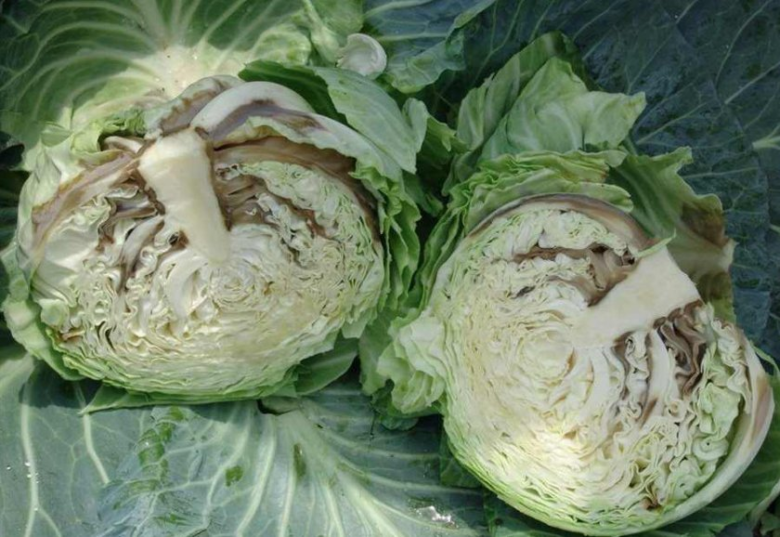
How to deal with vascular bacteriosis?
- first of all, observe crop rotation (the bacterium lives in the soil for up to 3 years), the best predecessors are peas, beans, cucumbers, beets
- fight weeds and harmful insects
- treat seeds and seedlings with biological preparations, for example: Fitolavin-300
There are many varieties of hybrids F1disease resistant:
- Typhoon,
- Aggressor,
- Braksan,
- Dominant.
Vascular bacteriosis on cabbage
Mucous bacteriosis
The causative agents of mucous bacteriosis are bacteria Pectobacterium carotovorum subsp. carotovorum (Jones) Waldee. The disease affects many types of garden and weed plants. Distributed throughout the territory of the Russian Federation.
The first signs appear during the period of maturation of the heads of cabbage. Seedlings suffer less often. White cabbage and cauliflower are primarily affected.
Oily spots appear on the affected surface, a characteristic putrid smell. Cauliflower also has problems – rot spots appear on the inflorescences. Gradually, the entire head turns into a rotting mass. Rot can creep out of the soil along the stump, which becomes soft. Cabbage rots on the vine. Often joins in and promotes the development of rot, neighbor and brother – vascular bacteriosis… In storage, these vegetables completely rot.

Sources of infection:
- harmful insects (cabbage aphid, cabbage moth, slugs, various mites),
- plant residues,
- irrigation water,
- soil /
Contribute to the development of the disease:
- air humidity over 50%,
- high air temperature
- heavy rainfall.
Plant protection and crop protection methods:
- thoughtful agricultural technology (crop rotation, potash fertilization, careful crop care)
- pest and weed control
- growing disease resistant F1 hybrids
- healing seeds with TMTD
- as a prophylaxis, watering before planting the wells with the biological product “Binoram”
- cleaning and disinfection of vegetable stores
- storage mode at 0 … + 5 C.
Mosaic
The disease begins with the Cauliflower mosaic caulivirus, which is brought by various sap-sucking insects (aphids, herbivorous mites). Infected seeds, cruciferous weeds, mechanical damage to the surface of plants also contribute to the defeat of the virus.
From mosaics suffer all types of cabbage: white cabbage, kohlrabi, savoy, colored, leaf. And also cruciferous relatives: turnip, rutabaga, horseradish.
The first signs:
- veins in the form of a mosaic are indicated on young leaves.
- Dark green edges appear next.
- Necrotic spots appear on the leaf tissue between the edges.
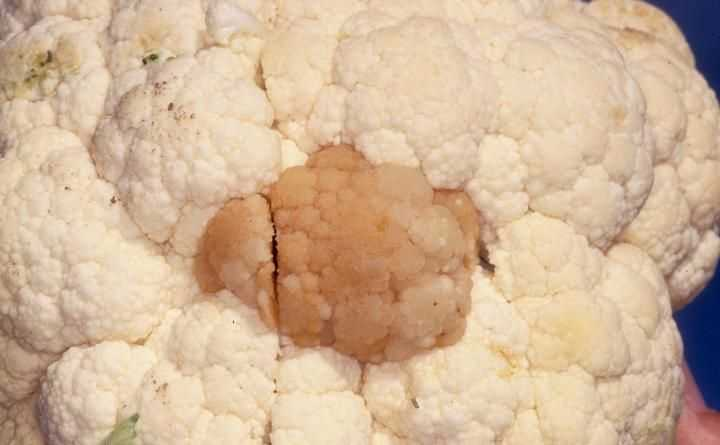
Usually, signs of the disease appear 20-30 days after transplanting. If a fever sets in, the vital activity of the virus temporarily stops.
The methods of fighting the virus are rather preventive:
- seed preparation, for example heat treatment (hot water, then bathing in cold water)
- seed treatment with biological, growth-stimulating drugs (“Phytocide”, Agat-25 “)
- diseased plants are burned
- weed control
- an uncompromising war on insect pests!
Effective methods of prevention and treatment of diseases
We already know a lot about cabbage diseases, so let’s summarize:
- Actively use the principles of crop rotation, plant cabbage in the same place no earlier than after 3 years
- Seedling preparation and processing
- Application of suitable fertilizers
- Breeding resistant F-1 hybrids
- General cleaning of the garden
- Digging the soil in late autumn
- Constant pest control
- Disinfection, soil leaching
Uff, it seems they haven’t forgotten anything …
Almost everything about cabbage diseases
Conclusion
In this article, we have collected for you all the useful information, all the accumulated experience of gardeners fighting cabbage diseases in the open field. If you disagree with something, we will be happy to hear your opinion. Maybe you know more effective methods for solving the problem, feel free to share your knowledge. Everybody has a rich harvest!
How to cure cabbage
